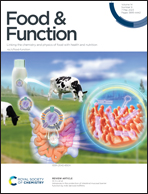Lactiplantibacillus plantarum attenuates Coxsackievirus B3-induced pancreatitis through the BAX/BCL2/CASP3 signaling pathway†
Abstract
Lactiplantibacillus plantarum is a lactic acid bacterium widely used in food production. Coxsackievirus B3 (CVB3) is an important human pathogen associated with acute pancreatitis development, and no antiviral therapeutics or vaccines are approved to treat or prevent its infection. However, whether L. plantarum could inhibit CVB3 infection remains unclear. Here, L. plantarum FLPL05 showed antiviral activity against CVB3 infection in vivo and in vitro. Pretreatment with L. plantarum FLPL05 reduced serum amylase levels, CVB3 viral load in the pancreas, serum pro-inflammatory cytokine levels, and macrophage infiltration in CVB3-infected mice. In mice, L. plantarum FLPL05 inhibited CVB3-induced pancreas apoptosis via the B cell leukemia/lymphoma 2 (BCL2)/BCL2-associated X protein (BAX)/caspase-3 (CASP3) signaling pathway. Furthermore, L. plantarum FLPL05 reduced CVB3 replication, protected cells from the cytopathic effect of CVB3 infection, and inhibited cell apoptosis. Moreover, L. plantarum FLPL05's exopolysaccharide (EPS) had activity against CVB3 in vitro, reducing the CVB3 titer and improving cell activity. Therefore, L. plantarum FLPL05 pretreatment improved CVB3-induced pancreatitis by partially reversing pancreatitis, which might be associated with EPS. Consequently, L. plantarum FLPL05 could be a potential probiotic with antiviral activity against CVB3.



 Please wait while we load your content...
Please wait while we load your content...